Kenneth C. Davis's Blog, page 33
November 20, 2020
Thanksgiving? Or Thankstaking? 400 years after the Mayflower — Don’t Know Much About® Audiominutes
This year is the 400th Anniversary of the arrival of the Pilgrims to Massachusetts and the signing of the Mayflower Compact. I serve up a helping of Thanksgiving History in my new Don’t Know Much About® AudioMinutes
https://dontknowmuch.com/wp-content/uploads/2020/11/New-Recording-10-1.m4a
For more on the history of the holiday, read my article, “How the Civil War Created Thanksgiving” (New York Times, November 25, 2014)
And here is another piece of America’s Hidden History —“A French Connection.” The story of the real first Pilgrims in the future United States. They were French in Florida, fifty years before the Mayflower sailed.
TO commemorate the arrival of the first pilgrims to America’s shores, a June date would be far more appropriate, accompanied perhaps by coq au vin and a nice Bordeaux.
–“A French Connection” (November 25, 2008)
November 17, 2020
Remembering the Nuremberg Trials: A Don’t Know Much About® Audiominute
The Nuremberg Trials — A Don’t Know Much About® Audiominute
75 years ago on November 20, 1945, in the aftermath of World War II, the first trials of Nazi war criminals began. This military tribunal, the Nuremberg Trials, as they came to be known, was convened by the four victorious Allies—Great Britain, France, the Soviet Union, and the United States.
Listen to this audiominute.
https://dontknowmuch.com/wp-content/uploads/2020/11/New-Recording-9.m4a
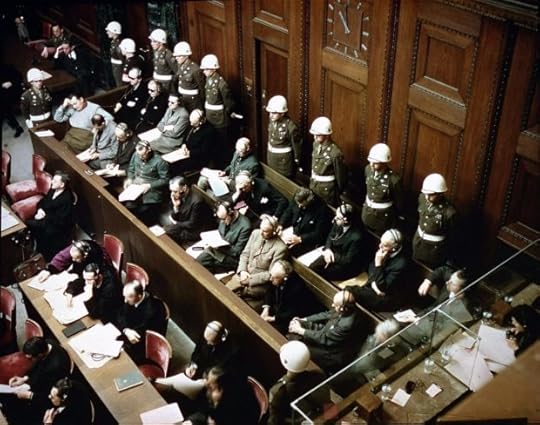
Defendants in the Dock at the Nuremberg Trials (Image: National Archives)
Read Robert Jackson’s full opening statement here.
This is an article about the Nuremberg Trials I wrote in 2005 for the Rutland (VT) Herald.
November 12, 2020
Two Veterans–A Dark Consequence of World War One: A Don’t Know Much About® Audiominute
Yesterday, November 11th, was Veterans Day – a holiday on which we honor service and sacrifice.
Two World War I veterans, Benito Mussolini and Adolf Hitler, deserve no such honors. But we must still recognize the consequences of war. Listen to this quick lesson.
https://dontknowmuch.com/wp-content/uploads/2020/11/New-Recording-8.m4a

Mussolini and Hitler in Munich June 1940 (Source: National Archives)
You can read and listen to more of my history of Veterans Day here.
And read more about these two men and the impact of World War I in the rise of other dictators in Strongman: The Rise of Five Dictators and the Fall of Democracy
Two Veterans: A Dark Consequence of World War One (A Don’t Know Much About® Audiominute)
Yesterday, November 11th, was Veterans Day – a holiday on which we honor service and sacrifice.
Two World War I veterans, Benito Mussolini and Adolf Hitler, deserve no such honors. But we must still recognize the consequences of war. Listen to this quick lesson.
https://dontknowmuch.com/wp-content/uploads/2020/11/New-Recording-8.m4a

Mussolini and Hitler in Munich June 1940 (Source: National Archives)
You can read and listen to more of my history of Veterans Day here.
And read more about these two men and the impact of World War I in the rise of other dictators in Strongman: The Rise of Five Dictators and the Fall of Democracy
November 11, 2020
Veterans, Poppies, and “In Flanders Fields”
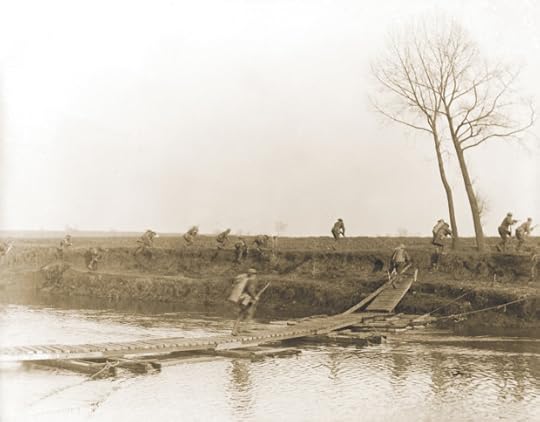
Soldiers of the 146th Infantry, 37th Division, crossing the Scheldt River at Nederzwalm under fire. Image courtesy of The National Archives.
One of the most famous symbols of the sacrifice and loss we mark on Memorial Day and Veterans Day is the Poppy, inspired by this World War I poem, “In Flanders Fields,” written by John McCrae.
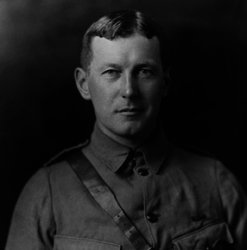
John McCrae, a Canadian doctor and teacher who is best known for his memorial poem “In Flanders Fields,”
In Flanders fields the poppies blow
Between the crosses, row on row,
That mark our place, and in the sky,
The larks, still bravely singing, fly,
Scarce heard amid the guns below.
We are the dead; short days ago
We lived, felt dawn, saw sunset glow,
Loved and were loved, and now we lie
In Flanders fields.
Take up our quarrel with the foe!
To you from failing hands we throw
The torch; be yours to hold it high!
If ye break faith with us who die
We shall not sleep, though poppies grow
In Flanders fields.
Source: The poem is in the public domain courtesy of Poets.org
“Soon after writing “In Flanders Field,” McCrae was transferred to a hospital in France, where he was named the chief of medical services. Saddened and disillusioned by the war, McCrae found respite in writing letters and poetry, and wrote his final poem, “The Anxious Dead.”
In the summer of 1917, McCrae’s health took a turn, and he began suffering from severe asthma attacks and bronchitis. McCrae died of pneumonia and meningitis on January 28, 1918.” (Poets.org)
Inspired by McCrae’s poem, an American woman, Moina Michael originated the idea of wearing red poppies to honor the war dead. She sold poppies with the money going to benefit servicemen, and the movement caught on, spreading to Europe as well. In 1948, Moina Michael was honored for founding the Poppy Movement with a red 3 cent postage stamp.
November 10, 2020
Poppies and Pandemics: A Don’t Know Much About® Audiominute
During World War I, the poem “In Flanders Fields” inspired the use of the poppy as the symbol of loss and remembrance on Veterans Day and Memorial Day. Read these posts for more about Veterans Day and about the poem “In Flanders Fields.”
What symbol, what icon, should we use to mark the tragic losses in the Covid pandemic — losses more deadly than war?
https://dontknowmuch.com/wp-content/uploads/2020/11/Poppies-Recording-7.m4a


Don’t Know Much About® History: Anniversary Edition

The Hidden History of America At War (paperback)
11-11-11: Don’t Know Much About Veterans Day-The Forgotten Meaning
“The eleventh hour of the eleventh day of the eleventh month.”
(This is a revised version of a post originally written for Veterans Day in 2011. The meaning still applies.)

Taken at 10:58 a.m., on Nov. 11, 1918, just before the Armistice went into effect; men of the 353rd Infantry, near a church, at Stenay, Meuse, wait for the end of hostilities. (SC034981)
On Veterans Day, a reminder of what the day once meant and what it should still mean.
That was the moment at which World War I –then called THE GREAT WAR– largely came to end in 1918, on the eleventh hour of the eleventh day of the eleventh month.
One of the most tragically senseless and destructive periods in all history came to a close in Western Europe with the Armistice –or end of hostilities between Germany and the Allied nations — that began at that moment. Some 20 million people had died in the fighting that raged for more than four years since August 1914. The formal end of the war came with the Treaty of Versailles in June 1919.
Besides the war casualties, an estimated 100 million people died during the war of the Spanish flu, a worldwide pandemic that was completely linked to the war and had an impact on its outcome. That is the subject of my recent book, More Deadly Than War:The Hidden History of the Spanish Flu and the First World War.

The date of November 11th became a national holiday of remembrance in many of the victorious allied nations –a day to commemorate the loss of so many lives in the war. And in the United States, President Wilson proclaimed the first Armistice Day on November 11, 1919. A few years later, in 1926, Congress passed a resolution calling on the President to observe each November 11th as a day of remembrance:
Whereas the 11th of November 1918, marked the cessation of the most destructive, sanguinary, and far reaching war in human annals and the resumption by the people of the United States of peaceful relations with other nations, which we hope may never again be severed, and
Whereas it is fitting that the recurring anniversary of this date should be commemorated with thanksgiving and prayer and exercises designed to perpetuate peace through good will and mutual understanding between nations; and
Whereas the legislatures of twenty-seven of our States have already declared November 11 to be a legal holiday: Therefore be it Resolved by the Senate (the House of Representatives concurring), that the President of the United States is requested to issue a proclamation calling upon the officials to display the flag of the United States on all Government buildings on November 11 and inviting the people of the United States to observe the day in schools and churches, or other suitable places, with appropriate ceremonies of friendly relations with all other peoples.
Of course, the hopes that “the war to end all wars” would bring peace were short-lived. By 1939, Europe was again at war and what was once called “the Great War” would become World War I. With the end of World War II, there was a movement in America to rename Armistice Day and create a holiday that recognized the veterans of all of America’s conflicts. President Eisenhower signed that law in 1954. (In 1971, Veterans Day began to be marked as a Monday holiday on the third Monday in November, but in 1978, the holiday was returned to the traditional November 11th date).
Today, Veterans Day honors the duty, sacrifice and service of America’s nearly 25 million veterans of all wars, unlike Memorial Day, which specifically honors those who died fighting in America’s wars.
We should remember and celebrate all those men and women. But lost in that worthy goal is the forgotten meaning of this day in history –the meaning which Congress gave to Armistice Day in 1926:
to perpetuate peace through good will and mutual understanding between nations …
inviting the people of the United States to observe the day … with appropriate ceremonies of friendly relations with all other peoples.
The Library of Congress offers an extensive Veterans History Project.
Read more about World War I and all of America’s conflicts in Don’t Know Much About History and Don’t Know Much About the American Presidents.
I discuss the role of Americans in battle in more than 240 years of American history in THE HIDDEN HISTORY OF AMERICA AT WAR: Untold Tales from Yorktown to Fallujah (Hachette Books and Random House Audio).
MORE DEADLY THAN WAR: The Hidden History of the Spanish Flu and the First World War was published in May 2018.


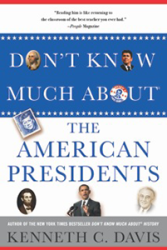
November 9, 2020
The Anniversary of “Kristallnacht”-A Don’t Know Much About® Audio Minute
On November 9th and 10th in 1938, an outburst of anti-Semitic violence swept across Hitler’s Germany.
An audio lesson on “Kristallnacht.”
https://dontknowmuch.com/wp-content/uploads/2020/11/New-Recording-5.m4a
Read more about Hitler’s Germany in Strongman: The Rise of Five Dictators and the Fall of Democracy
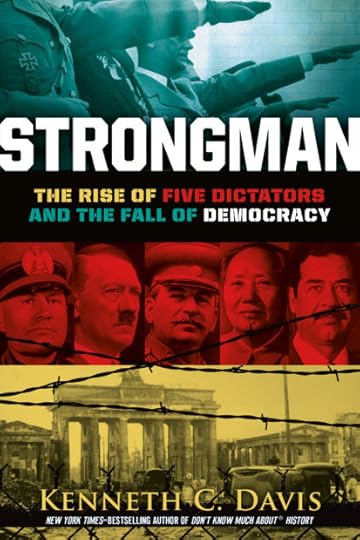
November 6, 2020
Just in: *Starred Review for Strongman from Publishers Weekly
Publishers Weekly has given Strongman a Starred Review:
This captivating history of five depraved “strongmen” offers a timely warning about the need to protect democracy. Davis (In the Shadow of Liberty) provides absorbing, clearly distilled biographies of Adolf Hitler, Saddam Hussein, Mao Zedong, Benito Mussolini, and Joseph Stalin, as well as profiles of their respective dictatorships and atrocities.
Publishers Weekly

Read the full Publishers Weekly Starred review here.
November 4, 2020
Dictators and Democracy: A Don’t Know Much About® Audio Minute
More than two thousand years ago, some Greek men gathered on a hill in Athens, raised their hands, and changed the world.
Listen to a quick history of “people power” and the threat posed to democracy by a Strongman.
https://dontknowmuch.com/wp-content/uploads/2020/11/New-Recording-2.m4a
Read more in Strongman: The Rise of Five Dictators and the Fall of Democracy




